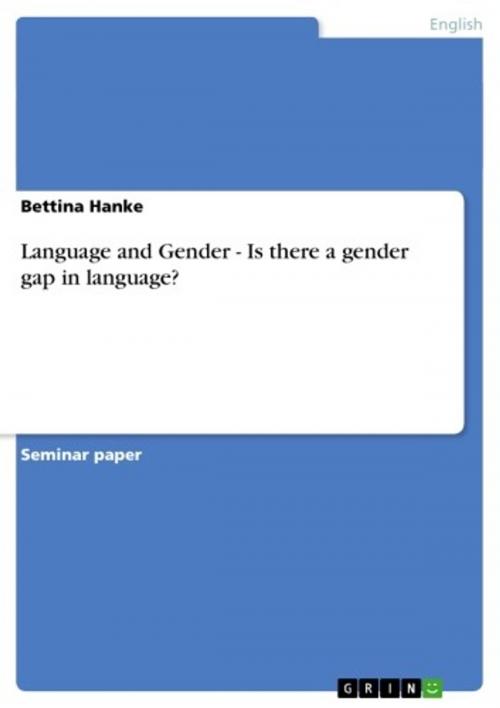Language and Gender - Is there a gender gap in language?
Is there a gender gap in language?
Nonfiction, Entertainment, Drama, Anthologies| Author: | Bettina Hanke | ISBN: | 9783638328418 |
| Publisher: | GRIN Publishing | Publication: | November 27, 2004 |
| Imprint: | GRIN Publishing | Language: | English |
| Author: | Bettina Hanke |
| ISBN: | 9783638328418 |
| Publisher: | GRIN Publishing |
| Publication: | November 27, 2004 |
| Imprint: | GRIN Publishing |
| Language: | English |
Seminar paper from the year 2003 in the subject English Language and Literature Studies - Linguistics, grade: 2,0 (B), Humboldt-University of Berlin (Anglistics/American Studies), course: The linguistic situation in the USA, 7 entries in the bibliography, language: English, abstract: The belief in sex differences has a long tradition. Researches of social scientists have helped to create and confirm this belief and have helped to develop theories which stress differences rather than similarities. Robin Lakoff was one of the first linguists who proposed that women´s speech style is a powerless style. She introduced the term 'women´s language' which implies that women and men speak different languages. Lakoff and others have claimed that differences in male and female language have their source in early childhood socialisation. The assertiveness training movement which emerged in the 1970s was first established to help people who have communication problems and was later designed especially for women to solve their alleged problems of speech style and male-female communication. In the 1980s another approach gained popularity. The origins lie in the work of the linguist John Gumperz. The two-cultures approach maintains that communication between women and men is communication across cultures because the reasons for misunderstanding between them are similar to those of ethnic groups. More recent works of Elizabeth Aries and Mary Crawford challenge these approaches and demonstrate that similarities between men and women are far greater than differences. In this paper I want to discuss several approaches to gender differences and try to answer the questions whether there are differences in male-female communication and what the causes are for these differences.
Seminar paper from the year 2003 in the subject English Language and Literature Studies - Linguistics, grade: 2,0 (B), Humboldt-University of Berlin (Anglistics/American Studies), course: The linguistic situation in the USA, 7 entries in the bibliography, language: English, abstract: The belief in sex differences has a long tradition. Researches of social scientists have helped to create and confirm this belief and have helped to develop theories which stress differences rather than similarities. Robin Lakoff was one of the first linguists who proposed that women´s speech style is a powerless style. She introduced the term 'women´s language' which implies that women and men speak different languages. Lakoff and others have claimed that differences in male and female language have their source in early childhood socialisation. The assertiveness training movement which emerged in the 1970s was first established to help people who have communication problems and was later designed especially for women to solve their alleged problems of speech style and male-female communication. In the 1980s another approach gained popularity. The origins lie in the work of the linguist John Gumperz. The two-cultures approach maintains that communication between women and men is communication across cultures because the reasons for misunderstanding between them are similar to those of ethnic groups. More recent works of Elizabeth Aries and Mary Crawford challenge these approaches and demonstrate that similarities between men and women are far greater than differences. In this paper I want to discuss several approaches to gender differences and try to answer the questions whether there are differences in male-female communication and what the causes are for these differences.















